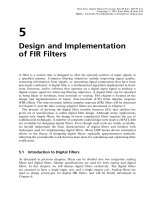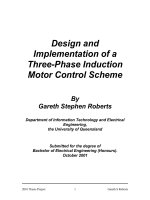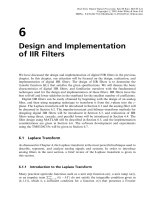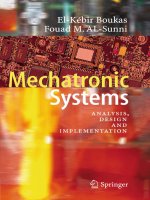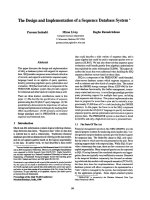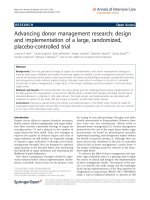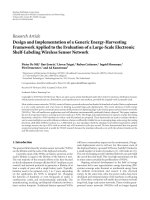Analysis, design and implementation of energy harvesting systems for wireless sensor nodes
Bạn đang xem bản rút gọn của tài liệu. Xem và tải ngay bản đầy đủ của tài liệu tại đây (21.4 MB, 349 trang )
ANALYSIS, DESIGN AND IMPLEMENTATION OF
ENERGY HARVESTING SYSTEMS FOR WIRELESS
SENSOR NODES
YEN KHENG TAN
NATIONAL UNIVERSITY OF SINGAPORE
2010
ANALYSIS, DESIGN AND IMPLEMENTATION OF
ENERGY HARVESTING SYSTEMS FOR WIRELESS
SENSOR NODES
YEN KHENG TAN
M.T.D.(Mechatronics) B.Eng(Hons.) NUS, Singapore
A THESIS SUBMITTED
FOR THE DEGREE OF DOCTOR OF PHILOSOPHY
DEPARTMENT OF ELECTRICAL AND COMPUTER
ENGINEERING
NATIONAL UNIVERSITY OF SINGAPORE
2010
Acknowledgments
I remember the first time I get to know my supervisor, Associate Professor Sanjib
Kumar Panda, was back in year 2001. At that time, I was taking one of his technical
module. Throughout the course, I was really impressed by his marvelous teaching
skill and great patience for guiding his students. From then onwards, I joined him
as a final year undergraduate student and subsequently as a master student. Along
the way, I am really fortunate to have his consistent encouragement and unlimited
care and concern, which brought me thus far into the postgraduate program. I
am also extremely grateful and obliged to my supervisor for his persistent help,
advice and encouragement during my entire Ph.D study. In addition, I would like
to express my sincere gratitude to P rof. Panda for spending his personal time for
the correction as well as revision of this thesis. I would never forget his sacrifice
for spending hours and hours with me for research discussions.
Other than the superb supervisory from Prof. Panda, I am really speechless to
express my greatest gratitude to Mr. Y.C. Woo, Principal Laboratory Technologist,
for his priceless help for my research project. To me personally, Mr. Woo is like
a highly respectable elder and his tender loving care and concern (TLC) for me
will remain in my heart forever. Whenever my spirits nose dived, he would always
be there to keep on encouraging me. His parental attitude towards the lab people
i
ii
dilutes the pressure and so the lab is really blessed by his presence. I would also like
to express my sincere gratitude to Mr. M. Chandra, Mr. T.T. Teo, Mr. H.C. Seow
and Mr. F.C. Looi for their timely helps and advices as well. I am also grateful
to Mr. L.H. Chan, Mr. H.K. Seah and Mr. Anuwar of Elec trical Engineering
Workshop for their constant and immediate help in the mechanical arrangements
for my experimental setup.
In my research laboratory here in NUS, I am really fortunate to be surrounded
by a bunch of good and friendly people, who are always there to help me inregard-
lessly. These people, whom are all my past and present lab-mates, include Dr.
Amit Kumar Gupta, Mr. Goh Qing Zhuang, Mr. Hoang Duc Chinh, Ms. Htay
Nwe Aung, Mr. Ko Ko Win, Dr. Kong Xin, Mr. Krishna Mainali, Ms. Li Yanlin,
Ms. Lim Shufan, Dr. Rajesh Kumar, Mr. Sangit Sasidhar, Mr. Siew Tuck Sing,
Dr. Tanmoy Bhattacharya, Mr. Tran Duong, Ms. Wang Huanhuan, Dr. Wu Xin-
hui, Mr. Yadav Parikshit, Ms. Yu Xiaoxiao, Dr. Yin Bo, Ms. Zhou Haihua, and
so on. I must express a big thank you to all of you for spending their valuable time
in all possible discussions and their precious company and help. I have really spent
a enjoyable and memorable life with them during my stay at NUS. In addition, I
would never forget my two beloved Indian brothers, Dr. S.K. Sahoo ”ji” and Mr.
Souvik Dasgupta ”Chhotu”. Not forgetting all my FYP students and other young
pupils that I have supervised before, I am deeply indebted for their contributions
in some ways or another towards my research project. Thank you all for being my
friends and teachers.
Last but not the least, I would like to dedicate the success of this Ph.D to my
beloved family members viz. father, mother, eldest brother and his family, second
iii
brother and his family and my highly respectable auntie. Their strong encourage-
ment, support, patience and most importantly love for me have accompanied me
through the entire time of my study, especially the darkest and hardest time. I
would remember deep down in my heart all of these wonderful and unforgettable
moments of my Ph.D study for the rest of my life.
Contents
Acknowledgements i
Table of Contents iv
Summary xii
List of Tables xx
List of Figures xxii
List of Acronyms xxxvi
List of Symbols xxxviii
1 Introduction 1
iv
Table of Contents v
1.1 Motivation of Wireless Sensor Networks . . . . . . . . . . . . . . . . 2
1.1.1 Architecture of WSN . . . . . . . . . . . . . . . . . . . . . . 2
1.1.2 Applications of WSN . . . . . . . . . . . . . . . . . . . . . . 7
1.1.3 Wireless Sensor Nodes of WSN . . . . . . . . . . . . . . . . 8
1.2 Problems in Powering Wireless Sensor Nodes . . . . . . . . . . . . . 10
1.2.1 High Power consumption of Sensor Nodes . . . . . . . . . . 10
1.2.2 Limitation of Energy Sources for Sensor Nodes . . . . . . . . 13
1.3 Energy Harvesting Solution for Wirele ss Sensor Node . . . . . . . . 17
1.3.1 Overview of Energy Harvesting . . . . . . . . . . . . . . . . 17
1.3.2 Energy Harvesting System . . . . . . . . . . . . . . . . . . . 21
1.3.3 Review of Past Works on Energy Harvesting System . . . . 23
1.4 Contribution of this Thesis . . . . . . . . . . . . . . . . . . . . . . . 33
1.5 Organization of the Thesis . . . . . . . . . . . . . . . . . . . . . . . 37
1.6 Summary . . . . . . . . . . . . . . . . . . . . . . . . . . . . . . . . 41
Table of Contents vi
2 Wind Energy Harvesting System 42
2.1 Direct WEH Approach using Wind Turbine-Generator . . . . . . . 44
2.1.1 Wind Turbine-Generator . . . . . . . . . . . . . . . . . . . . 46
2.1.2 Design of Efficient Power Management Circuit . . . . . . . . 50
2.1.3 Experimental Results . . . . . . . . . . . . . . . . . . . . . . 70
2.1.4 Summary . . . . . . . . . . . . . . . . . . . . . . . . . . . . 77
2.2 Indirect WEH Approach using Piezoelectric Material . . . . . . . . 79
2.2.1 Vibration-Based Piezoelectric Wind Energy Harvester . . . . 80
2.2.2 Characteristic and Performances of Piezoelectric Wind En-
ergy Harvester . . . . . . . . . . . . . . . . . . . . . . . . . . 94
2.2.3 Power Processing Unit . . . . . . . . . . . . . . . . . . . . . 100
2.2.4 Experimental Results . . . . . . . . . . . . . . . . . . . . . . 103
2.2.5 Summary . . . . . . . . . . . . . . . . . . . . . . . . . . . . 107
3 Thermal Energy Harvesting System 108
Table of Contents vii
3.1 Thermal Energy Harvester . . . . . . . . . . . . . . . . . . . . . . . 110
3.1.1 Description of Thermoelectric Generator . . . . . . . . . . . 111
3.1.2 Analysis of Thermal Energy Harvester . . . . . . . . . . . . 112
3.1.3 Characterization of Thermal Energy Harvester . . . . . . . . 115
3.2 Resistor Emulation based Maximum Power Point Tracker . . . . . . 118
3.3 Implementation of Optimal TEH Wireless Sensor Node . . . . . . . 124
3.3.1 Buck Converter With Resistor Emulation Based MPPT . . . 125
3.3.2 Energy Storage . . . . . . . . . . . . . . . . . . . . . . . . . 126
3.3.3 Regulating Buck Converter and Wireless Sensor Node . . . . 128
3.4 Experimental Results . . . . . . . . . . . . . . . . . . . . . . . . . . 129
3.5 Summary . . . . . . . . . . . . . . . . . . . . . . . . . . . . . . . . 133
4 Vibration Energy Harvesting System 135
4.1 Impact-Based VEH using Piezoelectric Pushbutton Igniter . . . . . 139
4.1.1 Piezoelectric Pushbutton . . . . . . . . . . . . . . . . . . . . 140
Table of Contents viii
4.1.2 Energy Storage and Power Processing Unit . . . . . . . . . . 145
4.1.3 Experimental Results . . . . . . . . . . . . . . . . . . . . . . 148
4.1.4 Summary . . . . . . . . . . . . . . . . . . . . . . . . . . . . 151
4.2 Impact-Based VEH using Prestressed Piezoelectric Diaphragm Ma-
terial . . . . . . . . . . . . . . . . . . . . . . . . . . . . . . . . . . . 152
4.2.1 Description of Prestressed Piezoelectric Diaphragm Material 155
4.2.2 Characteristic and Performance of THUNDER
PZT Uni-
morph . . . . . . . . . . . . . . . . . . . . . . . . . . . . . . 158
4.2.3 Power Management Circuit . . . . . . . . . . . . . . . . . . 163
4.2.4 Experimental Results . . . . . . . . . . . . . . . . . . . . . . 166
4.2.5 Summary . . . . . . . . . . . . . . . . . . . . . . . . . . . . 170
5 Hybrid Energy Harvesting System 172
5.1 Solar Energy Harvesting System . . . . . . . . . . . . . . . . . . . . 175
5.2 Composite Solar, Wind (S+W) Energy Sources . . . . . . . . . . . 180
5.2.1 Wind Energy Harvesting Sub-System . . . . . . . . . . . . . 182
Table of Contents ix
5.2.2 Solar Energy Harvesting Sub-System . . . . . . . . . . . . . 183
5.2.3 Hybrid Solar and Wind Energy Harvesting System . . . . . 191
5.2.4 Experimental Results . . . . . . . . . . . . . . . . . . . . . . 195
5.2.5 Summary . . . . . . . . . . . . . . . . . . . . . . . . . . . . 202
5.3 Composite Solar, Thermal (S+T) Energy Sources . . . . . . . . . . 203
5.3.1 Overview of Indoor Energy Sources . . . . . . . . . . . . . . 205
5.3.2 Indoor Solar Energy Harvesting Sub-System . . . . . . . . . 208
5.3.3 Thermal Energy Harvesting Sub-System . . . . . . . . . . . 210
5.3.4 Hybrid Energy Harvesting from Solar and Thermal Energy
Sources . . . . . . . . . . . . . . . . . . . . . . . . . . . . . 214
5.3.5 Experimental Results . . . . . . . . . . . . . . . . . . . . . . 222
5.3.6 Summary . . . . . . . . . . . . . . . . . . . . . . . . . . . . 230
6 Electrical Power Transfer with ‘no wires’ 231
6.1 Inductively Coupled Power Transfer from Power Lines . . . . . . . . 234
Table of Contents x
6.1.1 Magnetic Energy Harvester . . . . . . . . . . . . . . . . . . 235
6.1.2 Power Management Circuit . . . . . . . . . . . . . . . . . . 240
6.1.3 Experimental Results . . . . . . . . . . . . . . . . . . . . . . 244
6.1.4 Summary . . . . . . . . . . . . . . . . . . . . . . . . . . . . 248
6.2 Wireless Power Transfer via Strongly Coupled Magnetic Resonances 249
6.2.1 Concept Principles of WPT with Magnetic Resonance . . . . 251
6.2.2 Simulation Results . . . . . . . . . . . . . . . . . . . . . . . 257
6.2.3 Characteristic of WPT System . . . . . . . . . . . . . . . . . 262
6.2.4 Experimental Results . . . . . . . . . . . . . . . . . . . . . . 266
6.2.5 Summary . . . . . . . . . . . . . . . . . . . . . . . . . . . . 272
7 Conclusions and Future Works 273
7.1 Conclusions . . . . . . . . . . . . . . . . . . . . . . . . . . . . . . . 273
7.2 Future Research Works . . . . . . . . . . . . . . . . . . . . . . . . . 275
List of Publications 279
Table of Contents xi
Bibliography 283
Summary
With the recent advances in wireless communication technologies, sensors and actu-
ators and highly integrated microelectronics technologies, wireless sensor networks
(WSNs) have gained worldwide attention to facilitate monitoring and controlling of
physical environments from remote locations that could be difficult or dangerous-
to-reach. WSNs represent a significant improvement over wired sensor networks
with the elimination of the hard-wired communication cables and associated instal-
lation and maintenance costs. The possible use of WSNs for real-time information
in all aspects of engineering systems are virtually endles s, from intelligent building
control to health-care systems, environmental control systems, etc. As electronic
hardware circuitries become cheaper and smaller, more and more of these WSN
applications are likely to emerge, particularly as these miniaturized wireless sensor
nodes offer the opportunity for electronic systems to be embedded unobtrusively
into everyday objects to attain a “deploy and forget” scenario.
In great majority of autonomous sensor no des in WSNs, electrical energy
necessary for their operation is provided primarily by batteries. Batteries take
up a significant fraction of the total size and weight of the overall system. More-
over, they are also the weakest link but yet the most expensive part of the system.
Another very important factor to be considered is the requirement for proper main-
xii
Summary xiii
tenance of batteries, with the need to either replace or recharge them. This is a
serious limitation to WSNs, in which there are dozens or hundreds of sensor nodes
with batteries to maintain. Generally, the highest reported energy for present-
day battery technologies ranges around 3.78 kJ/cm
3
[1], which implies that for an
ultra-low-power miniaturized wireless sensor node with volumetric size of 1 cm
3
operating at an average power consumption of 100 µW to have a 10-year lifespan,
needs as large as a 10 cm
3
size battery. Thus, energy supply is one of the major
bottle neck for the lifetime of the sensor node and also constrained by the size of
the battery.
The major hindrances of the “deploy and forget” nature of the WSNs are
the limited energy capacity and unpredictable lifetime performance of the battery.
In order to overcome these problems, energy harvesting/scavenging, which har-
vests/scavenges energy from a variety of ambient energy sources and converts into
electrical energy to recharge the batteries, has emerged as a promising technology.
With the significant advancement in microelectronics, the energy and therefore the
power requirement for sensor nodes continues to decrease from few mWs to few tens
of µW level. This paves the way for a paradigm shift from the battery-operated con-
ventional WSN, that solely relies on batteries, towards a truly self-autonomous and
sustainable energy harvesting wireless sensor network (EH-WSN). Various types of
energy harvesting (EH) systems and their respective main components viz. energy
harvester (source), power management circuit, energy storage device and wire-
less sensor node (load) have been investigated and analyzed in this dissertation.
EH systems, based on wind energy harvesting (WEH), thermal energy harvesting
(TEH), vibration energy harvesting (VEH), solar energy harvesting (SEH), hybrid
energy harvesting (HEH) and magnetic energy harvesting, are designed to suit the
Summary xiv
target applications viz. ambient conditions and event/task requirements and then
implemented into hardware prototypes for proof of concept. To optimize these EH
systems, several different types of power-electronic based management circuits such
as active AC-DC converter, DC-DC converter with maximum power p oint tracking
(MPPT), energy storage and latching circuit, etc. have been introduced.
Like any of the commonly available renewable energy sources, wind energy
harvesting (WEH) has been widely researched for high power (> few MWs level)
applications. However, few research works on the small-scale WEH can be found
in the literature, that are used to power small autonomous sensors. Small-scale
WEH system has the problems of low magnitude generated output voltage and
low harvested electrical power, as such they pose severe constraints on the cir-
cuit design of the power management unit of the WEH wireless sensor node. To
overcome the above mentioned problems, an optimized WEH system that uses an
ultra-low-power management circuit with two distinct features: (1) an active recti-
fier using MOSFETs for rectifying the low amplitude AC voltage generated by the
wind turbine-generator (WTG) under low wind speed condition efficiently and (2)
a DC-DC boost converter with resistor emulation algorithm to perform maximum
power point tracking (MPPT) under varying wind speed conditions are proposed.
As compared to the conventional diode-bridge rectifier, it is shown that the ef-
ficiency of the active rectifier has been increased from 40 % to 70 % due to the
significant reduction in the on-state voltage drop (from 0.6 V to 0.15 V) across each
pair of MOSFETs used. The proposed robust low-power microcontroller-based re-
sistance emulator is implemented with closed-loop res istance feedback control to
ensure close impedance matching between the source and the load, resulting in
efficient power conversion. From the experimental test results obtained, an aver-
Summary xv
age electrical power of 7.86 mW is harvested by the optimized WEH system at
an average wind speed of 3.62 m/s, which is almost four times higher than the
conventional energy harvesting method without using the MPPT.
For space constraint applications where small-scale WEH system ne eds to be
as small as possible and highly portable, this type of conventional, large and bulky
WTG is not that suitable. As such, a novel method to harvest wind energy using
piezoelectric material (PZT) has been presented. The overall size of the proposed
PZT structure is much smaller, as compared to the WTG. Energy harvested from
the piezoelectric based wind energy harvester is first accumulated and stored in a
capacitor until there is sufficient stored energy to power the sensor node, a trigger
signal is then initiated to release the stored energy in the capacitor to the wind
speed sensor node. Experimental results obtained show that the harvested stored
energy of 917 µJ is used to detect wind speed beyond a certain threshold level of
6.7 m/s for an early warning of storm detection system.
In some places where wind energy source is not available, thermal energy har-
vesting (TEH) from ambient heat sources with low temperature differences have
recently received great attention but impeded by the challenges of low energy con-
version efficiency, inconsistency, low output power due to temperature fluctuation
and higher cost. To supplement the TEH scheme, an efficient power management
circuit that could maximize power transfer from the thermal energy source to its
connected electronic load is desirable over a wide range of operating conditions. In
this dissertation, a DC-DC buck converter with resistor emulation based maximum
power point (MPP) tracker is presented for optimal TEH scheme in sustaining the
operation of w ireless sensor nodes. From the experimental test results obtained, an
Summary xvi
average electrical power of 629 µW is harvested by the optimized TEH system at
an average temperature difference of 20 K, which is almost two times higher than
the conventional energy harvesting method without using MPPT scheme.
Electrical cables that are used in residential and industrial buildings to con-
nect the appliance to the control switch on the wall have been a cause of nuisance
as well as result in higher installation cost. Undesirable re-cabling implications
may also arise over time should the cable become faulty over time. To overcome
the problem, a batteryless and wireless remote controller is proposed to switch the
electrical appliances such as lights and fans ON/OFF in a wireless manner. In this
dissertation, two types of piezoelectric-based vibration energy harvesting (VEH)
systems are presented to harvest impact or impulse forces from human pressing a
button or switch action. By depressing (1) the piezoelectric pushbutton igniter or
(2) the pre-stressed piezoelectric diaphragm material, electrical energy is generated
and stored in the capacitor. Once sufficient energy is harvested, the batteryless and
wireless remote controller is powered up for operation.
Energy harvesting system itself has an inherent problem, that is the inter-
mittent nature of the ambient energy source; hence the operational reliability of
the wireless sensor node may be compromised due to unavailability of the ambient
energy source for a prolonged perio d of time. To augment the reliability of the
wireless sensor nodes operation, two types of hybrid energy harvesting (HEH) ap-
proaches are investigated. A hybrid of wind and solar energy harvesting scheme
is proposed to harvest simultaneously from both energy sources in order to extend
the lifetime of the wireless sensor node. When the two energy sources of different
characteristics are combined together, it is bound to have the issue of impedance
Summary xvii
mismatch between the two different sources and the load. Hence, each energy
source has its own power management unit to maintain at its respective maximum
power points (MPPs). The WEH sub-system uses the resistor emulation technique
while the SEH sub-system uses the constant voltage technique for MPP operation.
Experimental results obtained show that an average electrical power of 22.5 mW
is harvested by the optimized HEH system at an average wind speed of 4 m/s and
an average light irradiance of 80 W/m
2
, which is almost three times higher than
the single wind-based energy source.
In another HEH research work, a hybrid of indoor ambient light and thermal
energy harvesting scheme that uses only one power management circuit to condi-
tion the combined output power harvested from both energy sources is proposed to
extend the lifetime of the wireless sensor node. By avoiding the use of individual
power management circuits for multiple energy sources, the number of components
used in the HEH system are reduced and the system form factor, cost and power
losses are thus reduced. An efficient microcontroller-based ultra low power man-
agement circuit with fixed voltage reference based MPPT is implemented with
closed-loop voltage feedback control to ensure near maximum power transfer from
the two energy sources to its connected electronic load over a wide range of operat-
ing conditions. From the experimental test results obtained, an average electrical
power of 621 µW is harvested by the optimized HEH system at an average indoor
solar irradiance of 1010 lux and a thermal gradient of 10 K, which is almost triple
of that can be obtained with conventional single thermal-based energy source.
Other than energy harvesting, this dissertation has also demonstrated an
alternative means to remotely power low-power electronic devices through wireless
Summary xviii
power transfer (WPT) mechanism. The WPT mechanism uses the concept of
inductive coupling i.e. by harvesting the stray magnetic energy in power lines to
transfer electrical power without any physical connection. The AC voltage and
current in the p ower lines are 230 V and 1-4 A. Experimental results obtained
show that the implemented magnetic energy harvester is able to harvest 685 µJ of
electrical energy from the power lines to energize the RF transmitter to transmit
10 packets of 12-bits encoded digital data to the remote base station in a wireless
manner. To extend the WPT distance, self-resonating coils, operating in a strongly
coupled mode, is demonstrated. Experimental results obtained show that the WPT
system is capable of delivering wireless output power up to 1 watt at an efficiency
of 51 % over a separation distance of 20 cm to power a small light bulb.
Till this stage, the proof of concepts for the developed energy harvesting
(EH) prototypes have been demonstrated. The performances of the EH systems in
powering the wireless sensor node are investigated and tested under various oper-
ating conditions simulated in the laboratory. In addition, the EH prototypes are
optimized according to their designed applications. However, in reality, the envi-
ronmental conditions of the deployment area are not as ideal as in the laboratory
environment. Hence, the next stage of this EH research, which is considered as the
future work, is to carry out a series of application-specific field trials to evaluate
the performances of the EH systems under real-life deployment conditions for a
prolong period of time. In order for the energy harvesting mechanism to be suc-
cessful, an overall system optimization with respect to energy consumption taking
into account the duty-cycling operation of the WSNs for the entire chain i.e. from
sensing the environmental parameter to transmitting and delivering the sensed pa-
rameter reliably is to be investigated. This part of the work is beyond the scope of
Summary xix
this dissertation and therefore proposed as future research work.
List of Tables
1.1 Battery life estimation for a Xbow sensor node operating at 100 %
and 1 % duty cycles [21] . . . . . . . . . . . . . . . . . . . . . . . . 11
1.2 Energy harvesting opportunities and demonstrated capabilities adapted
from [27] . . . . . . . . . . . . . . . . . . . . . . . . . . . . . . . . . 19
2.1 Relationship between incoming wind speed and tip deflection of the
cantilever piezoelectric wind harvester beam . . . . . . . . . . . . . 90
2.2 Properties of piezoelectric material . . . . . . . . . . . . . . . . . . 94
3.1 Main parameters of Thermo Life
prototype. . . . . . . . . . . . . 110
4.1 Technical Specifications of TH7R . . . . . . . . . . . . . . . . . . . 157
4.2 Maximum energy available for harvesting under various input forces 161
4.3 Power consumption of RF transmitter load . . . . . . . . . . . . . . 164
xx
List of Tables xxi
5.1 Power consumption of associated control, sensing and PWM gener-
ation electronic circuits . . . . . . . . . . . . . . . . . . . . . . . . . 194
5.2 Characteristics of Indoor Energy Sources . . . . . . . . . . . . . . . 205
5.3 Performance of Energy Harvesters under Indoor Conditions (adapted
from [27]) . . . . . . . . . . . . . . . . . . . . . . . . . . . . . . . . 206
6.1 Measured and calculated induced emf voltage for difference current
flowing in the power line . . . . . . . . . . . . . . . . . . . . . . . . 238
6.2 Efficiency of WPT system powering different light bulbs . . . . . . 268
List of Figures
1.1 Architecture of WSN to facilitate smart environments [4] . . . . . . 3
1.2 Sensor networks protocol stack [4] . . . . . . . . . . . . . . . . . . . 4
1.3 Block diagram of a wireless sensor node . . . . . . . . . . . . . . . . 9
1.4 Expected battery life vs system current usage and duty cycle [21] . 12
1.5 Ragone plot for comparing the energy storage technologies and their
power density versus energy density characteristics [22] . . . . . . . 14
1.6 Energy harvesting sources and their energy harvesters, adapted from
[29] . . . . . . . . . . . . . . . . . . . . . . . . . . . . . . . . . . . . 18
1.7 General block diagram representation of energy harvesting system
unit . . . . . . . . . . . . . . . . . . . . . . . . . . . . . . . . . . . 22
1.8 Examples of solar energy harvesting system [33] - [35] . . . . . . . . 25
1.9 Examples of thermal energy harvesting system [37], [40], [43] . . . . 27
xxii
List of Figures xxiii
1.10 Examples of thermal energy harvesting system [46], [47], [49] . . . . 29
1.11 Examples of thermal energy harvesting system . . . . . . . . . . . . 32
2.1 Functional block diagram of wind energy harvesting (WEH) wireless
sensor node . . . . . . . . . . . . . . . . . . . . . . . . . . . . . . . 44
2.2 Nominal monthly wind speed in a typical deployment location over
a perio d of 30 days in year 2006 . . . . . . . . . . . . . . . . . . . . 48
2.3 Functional block diagram of wind turbine-generator . . . . . . . . . 48
2.4 Power curves of wind turbine generator over a range of load resistances 49
2.5 Schematic diagram of full bridge active mosfet rectifier . . . . . . . 51
2.6 Experimental waveforms of active MOSFET full-bridge rectifier us-
ing voltage sense approach resulting in excessive oscillation . . . . . 52
2.7 Experimental waveforms of active MOSFET full-bridge rectifier us-
ing proposed current sense approach at optimal load condition . . . 53
2.8 Voltage drop comparison between diodes and MOSFETs (V) over a
range of load resistance (Ω)
. . . . . . . . . . . . . . . . . . . . . . 54
2.9 Electrical power generated by active and passive rectifiers at optimal
load condition . . . . . . . . . . . . . . . . . . . . . . . . . . . . . . 55
